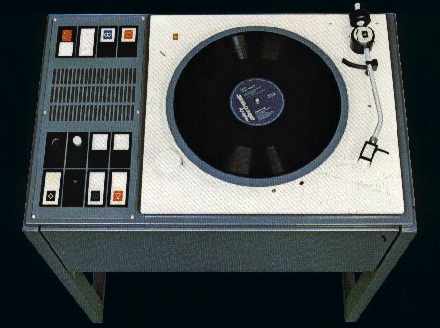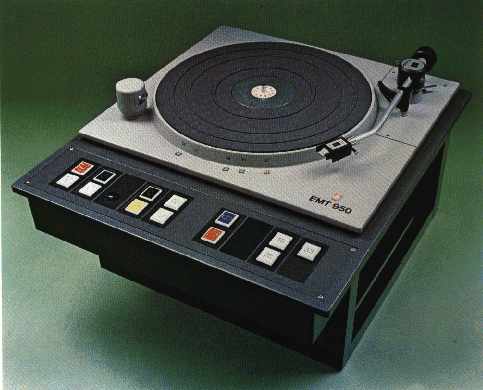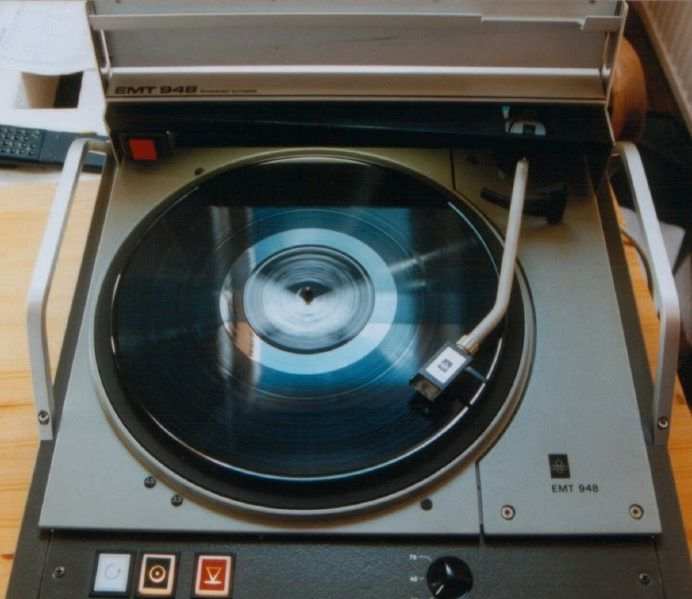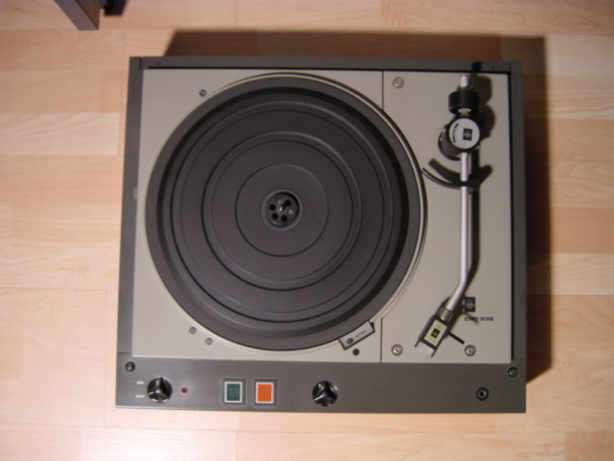| HOME |
| DirectDrive - The Hows And Whys |
| DirectDrive - Owning a DD |
| DirectDrive - Museum |
| DirectDrive - Tech-Talk |
| DirectDrive - Tonearms |

EMT-decks were never meant for the domestic-market since EMT was the leading company for transcription-turntables sold to broadcast-studios all over the world. 1976 was the year when EMT made his first Direct-Drive deck - the "Schallplatten-Wiedergabe-Maschine 950" (ooh! what a name). The 950 and its little brother the 948 are real symbols of "Made In Germany". With their high prices and their dead-serious professional design no audiophile in the 70's or 80's had an EMT at home. That changed at the end of the 80's - at least here in Germany - when the broadcasting-studios got rid of their decks in favor of the CD and lots of people bought an EMT-deck for domestic use. Even today you get spare-parts for them in Lahr/Germany - at hefty prices.
EMT 950

The platter itself was extremely light and made out of resin (resonance is quite similar to vinyl-discs). 2nd hand wise here in Germany you come across an EMT quite easily, since most broadcast-studios had got rid of them during the 80's. Since then a lot of machines made their way to the land of the rising sun with japanese audiomaniacs paying very high prices for these decks. An EMT 950 costs around 2000,- Dollars in Europe with restored or "like-new" machines reaching 3000,- Dollars.
The sound of this deck is very good, too. Even with the quite mediocre 929-tonearm and the almost 30 years old electronics you really get what you'd paid for. As everything works together perfectly you should check that your 950 has the STX-21 MC-transformer on board and use it with a TSD-15. Then forget about turntables and listen to the music...
EMT 948

Around 1979 the 948 was introduced as a little brother of the 950. It did not have all the
gimmics of the 950, but the electronics are almost the same. The big difference of the 948
was its compact newly developed suspension, less mass (nonetheless around 50pds. without plinth),
and a compact chassis which allowed the unit to be used in mobile-studios and little rooms.
The suspension of the 948 is unique with a ring located at the bottom which worked against the torque
of the strong motor. Arm (929), Pickup (TSD-15) and electronics are the same as with the EMT 950.
Sonically its performance is comparable to its big brother so if you don't need the ultimate look of the
950 the 948 is the ticket at around 1500,- Euros today.
As with all EMT's assure yourself that the STX-21 MC-transformer is on board, plug in a TSD-15 and be
happy. EMT's are obviously a tweaker's nightmare, anything you'll do will spoil the deck.
EMT 938

Introduced at the end of the 70's the "little" 938 is some kind of a cheaper, domesticated 948.
The suspension is almost identical to the 948 with simpler electronics and no gimmics like
push-button back-spinning but quite a pretty plinth (at least compared to the other EMT's).
So if you're looking for an EMT with a minimum of WAF here it is.
Audio-Electronics are quite good and work very well with the EMT TSD-15 cart, so take care the (active) MC
stage is on board. There was a second version for Moving-Magnet carts which is not that desirable. Nowadays
an EMT 938 changes his owner at around 1000,- Dollars. Not too bad if you consider the fully symetrical,
good sounding RIAA-Phono-amp on board.
Near relatives of the 938 are the Thorens TD-524 (Thorens TP-16 tonearm) and TD-738 (Thorens TP-29 tonearm
the same as the EMT 929...). These models aimed at the professional market and offered features like remote
control and pitching (up to 25%!).